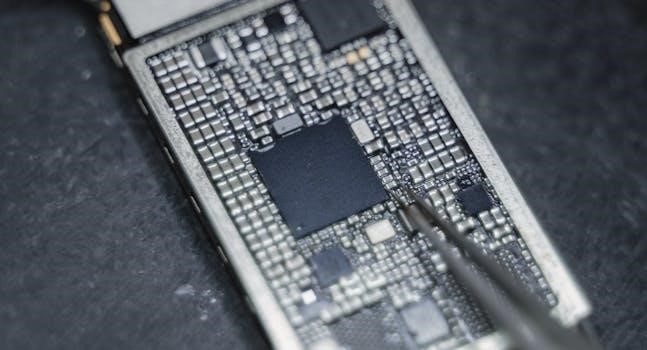Nortel Networks‚ headquartered in Canada‚ was a major player in telecommunications. They offered networking equipment and phone systems‚ becoming a familiar presence in businesses. Nortel systems required specialized knowledge for implementation and configuration.
Overview of Nortel’s Legacy in Telecommunications
Nortel‚ formerly a multinational telecommunications giant based in Canada‚ left a significant mark on the industry. As a leading provider of networking and communications equipment‚ Nortel systems were widely adopted by businesses seeking reliable telephony solutions. Their product lines spanned from digital to IP phones‚ catering to diverse organizational needs. Nortel’s innovation shaped the telecommunications landscape‚ influencing how businesses communicated. While Nortel faced challenges and ultimately dissolved‚ its impact remains evident in the installed base of systems and the continuing need for support and documentation. Understanding Nortel’s legacy is crucial for those managing or maintaining these systems today. Keeping the Nortel network is supported and reliable.
Importance of Manuals for Nortel Phone System Operation
Nortel phone systems‚ while robust‚ often require detailed manuals for proper operation and maintenance. These manuals serve as essential guides for users and administrators alike‚ providing instructions on everything from basic call handling to advanced system configuration. With Nortel systems‚ specific feature codes and programming steps are crucial for customizing phone functionalities to individual needs. Manuals offer step-by-step guidance on tasks such as call forwarding‚ voicemail setup‚ and speed dial programming. They also contain vital troubleshooting information‚ helping users diagnose and resolve common issues. Accessing and understanding Nortel phone system manuals is crucial for maximizing the system’s capabilities and ensuring smooth communication within an organization. Manuals offer assistance with guidance on keeping a system operational.

Nortel Phone Models and Series
Nortel offered diverse phone models‚ including digital M7xxx and T7xxx series. These phones were integral to Norstar and Meridian systems‚ offering various features for business communication‚ requiring specific manuals for effective use.
Digital Phones⁚ M7xxx and T7xxx Series
The M7xxx and T7xxx series represent Nortel’s digital phone offerings‚ commonly found in Norstar and Meridian systems. These phones provided reliable communication features for businesses. Models like the M7310 and T7316E were popular choices‚ each with specific functionalities outlined in user manuals.
These digital phones utilized proprietary protocols for communication‚ differing from modern IP-based systems. Configuring features like call forwarding‚ speed dials‚ and voicemail required accessing specific programming codes and settings‚ typically detailed within the Nortel system’s administration guide. Understanding the nuances of these digital phones is crucial for maintaining older Nortel systems.
User guides and reference materials are invaluable for troubleshooting and utilizing the full potential of the M7xxx and T7xxx series. These resources offer insights into button functions‚ display information‚ and system-specific feature codes‚ ensuring efficient operation and user satisfaction within a Nortel environment.
IP Phones⁚ 11xx‚ 12xx‚ and i2xxx Series (UNISTIM and SIP)
Nortel’s IP phone offerings included the 11xx‚ 12xx‚ and i2xxx series‚ supporting both UNISTIM and SIP protocols. The 11xx and 12xx series could utilize a provisioning server for configuration and firmware updates. These IP phones offered advanced features and integration capabilities compared to their digital counterparts.
The i2xxx series‚ including models like the i2050 softphone‚ primarily used the UNISTIM protocol. Configuring these phones often involved accessing the system’s administration interface or utilizing specific feature codes. User manuals provided detailed instructions on setting up features like call forwarding and speed dials.
Understanding the differences between UNISTIM and SIP protocols is crucial for proper configuration and troubleshooting. SIP-based phones offered greater interoperability with other VoIP systems. Accessing technical documentation and support resources is essential for managing and maintaining these Nortel IP phone systems effectively‚ ensuring optimal performance and user experience.

Basic Phone Operations
Basic phone operations on Nortel systems include making and answering calls. Consult your Nortel phone’s user guide for specific instructions. Lift the handset or press the hands-free button to initiate calls.
Making and Answering Calls
Operating a Nortel phone system begins with the fundamentals⁚ making and answering calls. To initiate an outbound call‚ lift the handset or activate the hands-free speaker option‚ usually indicated by a dedicated button. Following this‚ dial the desired phone number‚ ensuring you include any necessary prefixes for external lines‚ as determined by your system’s configuration.
Answering incoming calls is equally straightforward. When the phone rings‚ lift the handset to establish the connection. Alternatively‚ you can press the answer button‚ or the hands-free button to answer via the speakerphone. Some Nortel models might offer a visual indicator‚ such as a flashing light‚ to signal an incoming call‚ simplifying call management.
For specific features‚ consult the appropriate Nortel user manual.
Transferring Calls
Transferring calls on a Nortel phone system is a common task‚ essential for efficient communication within an organization. Begin by pressing the “Transfer” key during an active call‚ or use the feature code “Feature 70”. Next‚ enter the extension number of the person or department to whom you wish to transfer the call.
At this point‚ you have the option to announce the call‚ informing the recipient about the caller’s identity and purpose. Alternatively‚ you can simply hang up‚ completing the transfer without an announcement. In some Nortel systems‚ you might need to press the “Transfer” key again to finalize the transfer after entering the extension number.
Refer to your Nortel phone system’s user manual for specific instructions and variations‚ as the exact procedure can differ slightly depending on the model and configuration.

Advanced Features and Programming
Nortel phone systems offer advanced features like call forwarding‚ directing calls to another number‚ and voicemail‚ storing messages when unavailable. Programming these features often requires specific codes and access levels.
Call Forwarding and Voicemail
Nortel phone systems provide call forwarding‚ which is a feature that allows users to redirect incoming calls to another number. This is useful when someone is away from their desk or needs calls routed to a different location. Configuring call forwarding typically involves entering a specific feature code followed by the destination number‚ which is detailed in the Nortel phone system manual.
Voicemail is another essential feature‚ enabling callers to leave messages when the intended recipient is unavailable. Accessing voicemail usually involves dialing a designated extension or feature code‚ then entering a password for security. The Nortel documentation outlines how to set up voicemail boxes‚ record greetings‚ and manage stored messages. Furthermore‚ some Nortel systems allow remote access to voicemail‚ enabling users to check messages from outside the office.
Both call forwarding and voicemail settings can often be customized via the phone’s keypad or through a system administrator interface‚ as described within your Nortel Phone System Manual.
Speed Dials and Feature Codes
Nortel phone systems enhance user efficiency through speed dials and feature codes. Speed dials allow users to program frequently called numbers for quick access‚ eliminating the need to manually dial each time. Consult the Nortel phone system manual for specific instructions on programming speed dial numbers‚ as the process can vary depending on the phone model.
Feature codes are special sequences of digits that activate specific phone system functions‚ such as call forwarding‚ call transfer‚ or conference calling. The Nortel documentation provides a comprehensive list of feature codes and their corresponding functions. Understanding and utilizing these codes can significantly streamline communication tasks. For example‚ a feature code might be used to directly access a voicemail box or activate a “do not disturb” setting.
System administrators often customize feature codes based on organizational needs‚ so consulting with them and referencing the specific Nortel phone system manual is crucial for accurate usage.
Configuring Phone Settings via Extension Terminal
Nortel phone systems often allow configuration of phone settings directly through an extension terminal. This method provides users with the ability to personalize their phone’s behavior and features without needing administrator intervention for basic modifications. Accessing the configuration menu typically involves entering a specific sequence of digits on the phone’s keypad‚ as detailed in the Nortel phone system manual.
Once in the configuration menu‚ users can adjust settings such as ringtone volume‚ display preferences‚ and call forwarding options. The exact settings available will depend on the phone model and the system’s programming. The Nortel manual provides step-by-step instructions for navigating the configuration menu and modifying each setting. It is important to carefully follow these instructions to avoid unintended changes to the phone’s functionality.
Some advanced settings may require administrator privileges to modify‚ ensuring system-wide consistency and security.
Maintaining a Nortel phone system involves addressing common issues. User guides and manuals offer solutions to problems and provide instructions. Keeping your system operational and effective requires technical documentation.
Common Issues and Solutions
Nortel phone systems‚ while reliable‚ can encounter issues. These range from call quality problems and phone display malfunctions to voicemail retrieval difficulties and network connectivity disruptions. Addressing these promptly ensures smooth communication. Start by checking physical connections‚ like cables‚ and power supplies. Verify settings such as call forwarding and voicemail configurations. Consult user manuals and technical documentation for specific error codes and troubleshooting steps. For IP phones‚ confirm network settings and connectivity to the provisioning server. If problems persist‚ seek assistance from qualified telecommunications technicians familiar with Nortel systems. Regular inspections and proactive maintenance can prevent many common issues‚ optimizing performance and extending the lifespan of your Nortel phone system.
Firmware Updates and Configuration via Provisioning Server
Nortel’s 11xx and 12xx series IP phones‚ along with others‚ support firmware updates and configuration through a provisioning server. This centralized approach simplifies management‚ ensuring consistent settings and the latest features across numerous phones. To utilize this‚ configure the phones to connect to the TFTP provisioning server. The server then delivers configuration files and firmware updates automatically. Refer to specific Nortel documentation for the precise steps and server settings required for each phone model. Regular firmware updates are crucial for security patches‚ bug fixes‚ and improved performance. Ensure the provisioning server is properly maintained and accessible on the network. Properly configured provisioning streamlines administration and keeps your Nortel IP phones operating optimally.

Troubleshooting and Maintenance
Accessing Technical Documentation and Support
Obtaining technical documentation and support is vital for maintaining Nortel phone systems. User guides‚ manuals‚ and feature code lists are essential resources for troubleshooting and configuration. Several online sources offer Nortel Meridian and Norstar manuals for free download‚ providing detailed instructions. For specific issues‚ consulting technical documentation or contacting a Nortel support specialist is recommended. High Country offers assistance with documentation‚ manuals‚ and guidance for operational effectiveness. Explore online forums and communities where users share experiences and solutions. Remember to check for administrator guides and programming tips for Norstar systems. Proper access to documentation and support ensures the continued reliability and functionality of your Nortel phone system. Leverage available resources to address technical challenges efficiently and effectively.